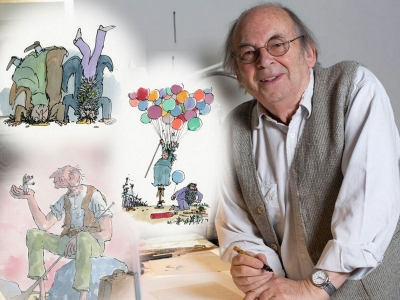
Who is Quentin Blake?
An English cartoonist, illustrator and designer, Quentin Blake is known for his collaborations with children’s author Roald Dahl. Through his expressive style, Blake breathed life into Dahl’s endearing characters such as the gentle BFG, the graceful Matilda, and the toe-curling Witches. He also created other memorable characters in children’s literature. And there is no stopping the octogenarian. He continues to sketch, winning the hearts of millions of children even today.
Early life
Blake grew up in Sidcup in the U.K. with a pencil in his hand. A self-taught artist, he never went to an art school. He learned to draw on his own by poring over the technical plans, or drawings, of machines that his father, a civil servant, brought home.
At 16 while still in school, his first sketches were published in the Punch magazine. He entered the children’s book sphere when he illustrated “A Drink of Water” by John Yeoman in 1960. He went on to become the head of the illustration department at the Royal College of Art in 1978, and served there till 1986.
Friendship with Dahl
Blake became friends with Dahl when he began to draw the BFG, Dahl rejected the first two sets of illustrations and even sent Blake one of his old sandals with a note stating “this was what the BFG should be wearing and not the clumsy knee-length boots” that he drawn.
Blake went to visit Dahl at his home in Gypsy House, at Great Missenden, northwest of London. There he saw Dahl with his family, especially his granddaughter Sophie after whom the little girl in “The BFG” was named. It prompted him to re-think the character of the giant as he found a similarity between the BFG and Dahl. Both were “tall men who put dreams into the heads of children.” At first, he had drawn the BFG with a clown face. But he redrew him in a “gentler manner” and made him “grandfatherly.”
The making of Matilda
Like the BFG, Blake created the character of Matilda in his unique style. She was drawn repeatedly until her face exuded “not her intelligence exactly, but her magic powers”. Willy Wonka’s appearance was also Blake’s visualization. He drew Wonka like a sprite because everything that happened inside his factory seemed unreal, like a fairy tale.
Such examples show that Blake gave shape to Dahl’s characters in his own way and that he did not blindly follow Dahl’s instructions. Perhaps, that’s why Dahl entrusted only Blake with his work. Blake has illustrated almost all of his books. Dahl’s final book, “Billy and the Minpins” was the only children’s book Blake did not originally illustrate, but a new updated version includes Blake’s illustrations.
Centre for illustration
A new gallery dedicated to Quentin Blake will open in London in 2022. The Quentin Blake Centre for illustration will become the world’s largest public arts space.
The House of illustration in King’s Cross, founded by Blake in 2014, will make way for the new centre in Islington. The Quentin Blake Centre for illustration will be built at an estimated cost of whopping $8 million.
It will feature exhibition galleries, education studios, and events spaces.
It will also become a permanent home for Blake’s archive of over 40,000 drawings.
Oh really?
- Blake has worked with other children’s literature authors, including Russell Hoban, Joan Aiken, Michael Rosen and David Walliams. His own heavily illustrated and quirky books include “Mister Magnolia”, “Zagazoo” and “Loveykins”.
- Blake was honoured with a knighthood in 2013 for his work as an illustrator.
- So far, he was illustrated more than 300 books, Blake also works with hospitals and mental health units, decorating buildings with his sketches.
Picture Credit : Google

